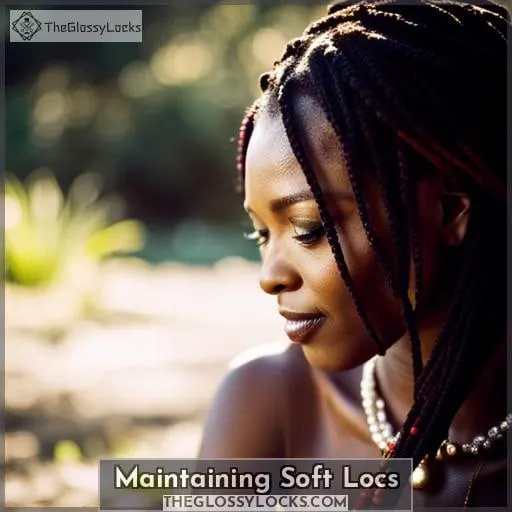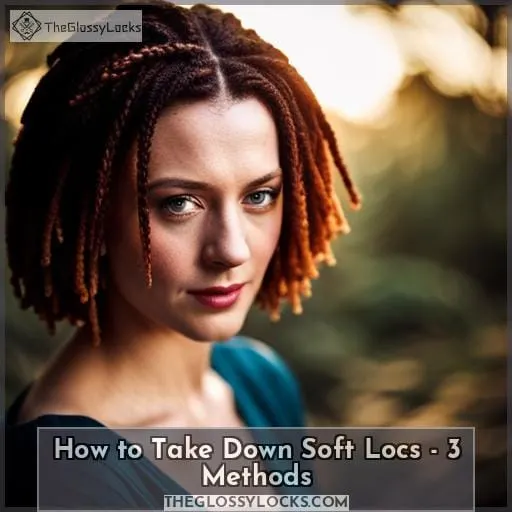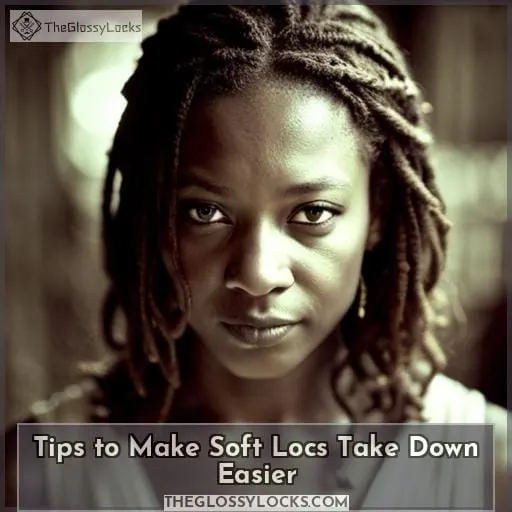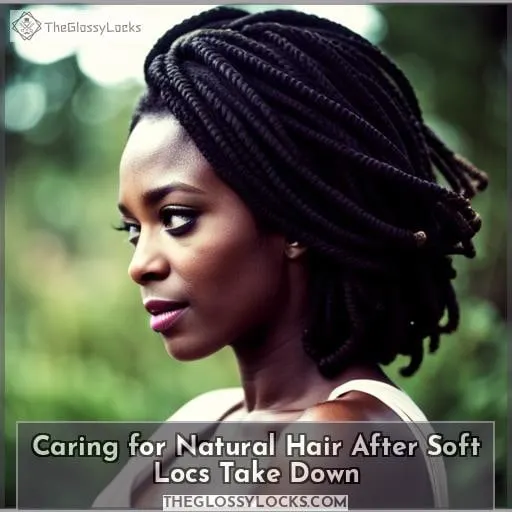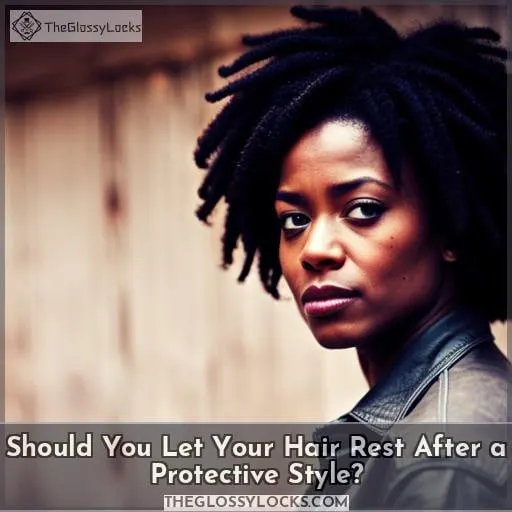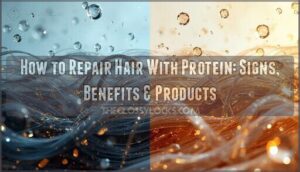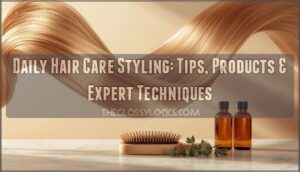This site is supported by our readers. We may earn a commission, at no cost to you, if you purchase through links.
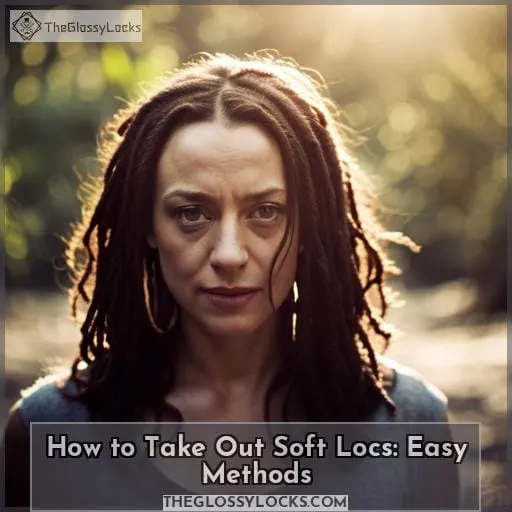
In this article, we’ll cover three methods for taking down soft locs that won’t damage your hair in the process. We’ll also discuss do’s and don’ts during removal, as well as tips on caring for your hair after it’s been taken down – all designed with liberation, power, and mastery in mind.
So read on if you’re ready to learn how to take out soft locs like a pro!
Table Of Contents
- Key Takeaways
- What Are Soft Locs?
- Maintaining Soft Locs
- How to Take Down Soft Locs – 3 Methods
- Soft Locs Take Down Do’s and Don’ts
- After Care for Soft Locs Take Down
- Tips to Make Soft Locs Take Down Easier
- Caring for Natural Hair After Soft Locs Take Down
- Should You Let Your Hair Rest After a Protective Style?
- Conclusion
Key Takeaways
- Soft locs can be removed using three methods: moisturizing and combing, careful cutting, and hand unraveling.
- Synthetic soft locs are easier to remove than real dreadlocks.
- Patience and oil are crucial for loosening the strands during removal.
- Gentle handling is important to prevent damage during the removal process.
What Are Soft Locs?
Soft locs provide a unique and stylish way to switch up your look, offering long-lasting style that can be customized to fit your individual needs. Soft Locs are synthetic hair extensions installed through crocheting into the natural hair, as opposed to real locs which form naturally over time.
Unlike traditional dreadlocks or regular loc styles, soft lock maintenance is easy but must still be done properly in order for it to last longer without damage or tension.
The benefits of this versatile look include minimal styling requirements (no need for daily brushing!), fewer visits required at the salon since there’s no need for re-twisting every few weeks like with braids or twists, and more freedom when it comes down to color selection – you can choose any color combination you desire!
But even though these locks may seem low maintenance compared to other protective hairstyles out there – such as box braids – it’s essential that careful attention is taken when caring for them in order not to cause breakage due to excessive dryness or build-up of product residue on the scalp.
This includes regularly moisturizing with water-based products, avoiding shampoo until removal, protecting them overnight with silk scarf/bonnets/pillowcases, etc., sealing ends using hot water instead of gel, and being mindful during nighttime activities including sleeping positions if possible.
When it’s finally time to remove soft locs, there are three methods available: Moisturizing & gentle combing out; Carefully cutting off; Unraveling by hand. It’s important to note here that because they’re made from synthetic fibers unlike real ones which have knots throughout each strand, removal will usually require less effort than taking out actual dreadlocks.
Aftercare post takedown also plays a very crucial role in maintaining healthy growth afterwards, so detangling any remaining sections left behind along with deep conditioning treatments should not be forgotten either!
In short, Soft Loc Installation offers great styling options but requires special attention to maintain their beauty, ultimately leading to a safe and pleasant takedown experience!
Maintaining Soft Locs
Maintaining soft locs is one of the most important aspects of having them installed. To keep your locs looking their best, it is essential to know how to take out soft locs in order to prevent damage and tension over time.
Avoiding Damage
To maintain your soft locs, it’s essential to keep them moisturized and hydrated like a thirsty plant in the desert. Protective styling, regular detangling sessions, and avoiding tight hairstyles are key for preventing damage.
Another crucial step is sealing cuticles with hot water post showering or rinsing out conditioner. This helps lock in moisture while nourishing strands from root to tip. By properly maintaining your soft locs, you can avoid any risks associated with taking them down, such as breakage or hair loss.
Here are a few additional tips to consider:
- Use silk pillowcases at night to reduce friction between fabric and hair.
- Learn how different types of takedown methods work best for each type of synthetic dreadlocks.
- Understand the aftercare steps needed following removal.
- Take care of the natural hair underneath, if applicable.
By following these simple steps, you can ensure that removing soft locs won’t have a negative effect on your mane!
Moisturizing and Hydrating
Hydrating and moisturizing your hair is essential for maintaining healthy, soft locs. Regular deep conditioning treatments, using natural oils to seal in moisture, and avoiding hot tools can all help protect your hair from dryness or damage.
When removing soft locs, follow these tips: moisturize the scalp before unraveling each section, use a detangling brush to gently separate strands, and condition after removal with light oil-based products.
Cleaning Soft Locs
Cleaning your soft locs can be tricky, so take extra care to avoid damaging them while doing so. Deep conditioning and moisturizing tips are essential for keeping your hair healthy and hydrated.
Protect the locs at night with a silk or satin cover, then use hot water to seal in moisture when necessary. Clarifying shampoo should only be used sparingly if needed; otherwise, stick with natural oils or conditioners that contain no harsh chemicals for deeper cleansing purposes.
Hair detangling is also important post-removal of soft locs using any of these three methods: moisturizing, careful cutting, or unraveling knots from braiding method installations.
Nighttime Protection
Protecting your soft locs overnight is essential for keeping them looking their best. Cover them with a silk or satin cover to prevent breakage and maintain moisture. Moisturize before bedtime as part of nighttime care to keep the hair hydrated and healthy.
Invest in good-quality covers that will protect your locks while you sleep, ensuring they look great each morning! Don’t forget hydrating tips like nightly spritzing with water-based products for an extra boost of moisture during the nighttime protection process.
How to Take Down Soft Locs – 3 Methods
When it comes to taking down soft locs, there are three popular methods: the knotless takedown, the scissor method, and the unravel-only technique. The knotless approach is recommended for beginners as it doesn’t require any cutting or styling tools.
For those looking for a quicker process with less messiness involved, then scissors may be preferred. Finally, if you want to keep your locs intact after being taken out without damaging them in any way, then unraveling only should be done carefully and patiently.
Method 1: Easy Knotless Take Down
Achieve a flawless soft locs takedown in no time with the easy knotless method! To begin, separate the natural hair from synthetic strands using your fingers and gently detangle. Then, apply slippery conditioner to soften and moisturize each strand for easier removal.
Finally, use scissors or an unravel-only method to take out the locs without damaging your own hair.
Method 2: Scissor Method
The scissor method is a quick and easy way to remove your soft locs, allowing you to say goodbye to the look without a knotty hassle. For this technique, all you need are scissors or shears equipped with rounded tips for safety and some patience.
Start by sectioning off one loc at a time near the scalp area so that each can be worked on separately. Cut through the base of each loc close enough until it unravels from itself but not too close where there will be excessive shedding or breakage when trying to detangle afterwards.
Alternatives such as unlatching each loop individually after soaking in hot water may require more effort but have less chance of damaging natural hair underneath faux locks.
Method 3: Unravel Only Method
Unraveling is the most time-consuming, but often least damaging way to remove soft locs. It can take up to 8 hours or more for a full head of hair! To begin the unraveling process, start by protecting your scalp and separating each faux loc.
Use a narrow-tooth comb on the ends first, then gradually work your way up until all sections are detangled.
When you’ve finished unraveling crochet faux locs, let the hair rest before transitioning into another protective style or caring for natural hair.
Soft Locs Take Down Do’s and Don’ts
When it comes to taking down soft locs, there are certain do’s and don’ts you should keep in mind to ensure a successful process.
Firstly, patience is key! Soft locs removal can take some time, so make sure you have the necessary amount of time set aside for the takedown.
Secondly, be gentle! Don’t tug or pull on your hair as this could cause damage and breakage.
Thirdly, choose a hard-working method that matches your hair type. If you have thinning edges or fine strands, opt for the root cut method. If not, try unraveling with a wide-tooth comb first before cutting off any excess length at the end.
Lastly, consider short-term protective styles such as bonnets/caps instead of opting straight away for a full soft locs takedown. These offer more flexibility when deciding whether to keep them installed longer than expected without compromising their health benefits over an extended period of wear.
With proper care and maintenance throughout wearing them, coupled with diligent attention during their removal process, soft locks will become one of your favorite protective styles, regardless of how long they remain in place!
After Care for Soft Locs Take Down
Now that you’ve taken out your soft locs, the next step is to take good care of them and your natural hair. Detangling with your fingers prior to shampooing or using a detangler can help make the process easier.
Getting slippery before attempting any kind of styling also helps reduce breakage and makes it easier for strands to move through each other without pulling or tugging on them too much.
Detangling With Fingers
Gently detangle your soft locs with your fingers to avoid pulling or tugging on the hair. Make sure you move slowly and delicately, as the slipperiness of natural hair can make it easy to get stuck in knots.
Finger detangling helps for a knotless takedown that leaves minimal breakage when removing faux locks.
Getting Hair Slippery
Slip your fingers between the locs and use gentle motions to create a slippery surface for easy removal.
Use protective styling products designed specifically for natural hair to reduce frizziness, hydrate strands, and protect your scalp.
Apply conditioner liberally throughout the hair before detangling in sections with a wide-toothed comb or even your fingers!
Deep conditioning treatments are also beneficial during soft locs removal. They provide lasting moisture while helping you preserve healthy locks post-take down.
Don’t forget about essential oils like coconut oil or jojoba, which can help soften up roots and make it easier to unravel each individual strand of synthetic fibers without causing split ends or breakage!
Detangling With Wide-Tooth Comb
Once your hair is slippery, use a wide-tooth comb to gently detangle the soft locs from root to tip.
For effective post-removal haircare, make sure you:
- Gently comb in sections starting at the ends and working up towards the roots.
- Take time when detangling – don’t pull too hard!
- Use a light oil before and after combing for extra moisture.
Detangling with a wide-tooth comb is essential for preventing damage while taking out soft locs. The key here is patience. Take your time as you work through each section and focus on using proper technique so as not to cause any breakage or pain while unraveling them.
Remember that if done correctly, removing soft locs can be easy but also requires care when handling delicate strands of synthetic locks during takedown processes like these.
Finishing With Narrow Tooth Comb
Now, use a narrow-tooth comb to finish detangling your locks and reveal their natural beauty. Choose a comb that suits the texture of your hair. Start at the ends and gently work up towards the roots in sections.
This will help you avoid breakage and maintain healthy, soft locs after removal care. Pay attention to each section to avoid missing any knots or tangles. Be careful not to tug too hard with either type of comb.
Clarifying Detangled Hair
After you’ve detangled your soft locks, it’s important to clarify your hair with a deep-cleansing shampoo. This helps remove product buildup and restore shine. You’ll want to use specific products or techniques for tangle removal that prevent damage while maintaining hydration levels in the hair.
Incorporate moisture-rich oils into the routine as well; this will help keep strands healthy and provide extra protection from breakage due to excessive combing or styling tools.
Tips to Make Soft Locs Take Down Easier
To make soft locs takedown easier, try using some of these tried and true tips to speed up the process and keep your hair looking its best:
- Preparation is key – comb through each strand with a wide-tooth comb prior to removal for detangling so you don’t have any difficulties during the removal process.
- Use products specifically designed for dreadlocks or synthetic hair, such as Marc Anthony Biotin Leave-In Conditioner or Kinky Curly Knot Today Conditioner, before beginning the takedown process.
- Utilize time-saving methods like pre-soaking overnight in warm water (while still wearing protective covers!).
- Try not to pull too hard when unraveling. Gently tugging at individual strands will save you lots of stress on both yourself and your scalp!
Taking out soft locs doesn’t have to be tedious if done correctly with proper preparation, product selection, techniques, and patience. These are all necessary tools required for a successful takedown experience! Whether opting for moisturizing shampooing instead of cutting off strands carefully or utilizing one of the other methods available like unraveling by hand, follow these simple steps outlined here today.
Caring for Natural Hair After Soft Locs Take Down
Once you’ve removed your soft locs, it’s time to get back to caring for your natural hair. Aftercare is an essential part of transitioning from wearing soft locs. Proper post-takedown care will help maintain the health and strength of your hair and prevent damage or breakage during the transition period.
- Immediately after removing locs, use a leave-in conditioner such as Marc Anthony Biotin Leave In Conditioner or Kinky Curly Knot Today Conditioner that contains nourishing ingredients like caffeine, ginseng, vitamin E, etc.
Which helps reduce split ends & breakage while providing hydration for a healthy scalp & shiny locks. Additionally, oiling can be done once or twice a week depending on individual needs.
- Trim off any damaged ends and deep condition weekly to promote hair hydration.
- Use protective styling techniques such as braids with extensions (e.g., box braids) or twists with extensions (e.
- Avoid using heat tools frequently and don’t use harsh chemicals or shampoos regularly.
By implementing these steps into your regular haircare routine, you can easily keep your fragile tresses away from unnecessary damage. Furthermore, protective styling methods such as braiding and twisting offer versatility in hairstyles that suit all face shapes without compromising quality.
Should You Let Your Hair Rest After a Protective Style?
It’s important to think about the health of your hair when deciding whether or not to wear a protective style. After taking out soft locs, you should consider taking a rest period for your hair in order to promote recovery and healthy growth.
During this time, it is still possible to switch up hairstyles without compromising on natural hair health.
- Give Your Hair Time To Recover: Make sure you give yourself enough time between styles so that your scalp can recover and strengthen before retightening or installing new locs.
- Use Gentle Products & Techniques: When transitioning from one style into another, use gentle products such as light oils and creams, as well as low-manipulation techniques like braiding instead of twisting.
- Mind Your Edges & Scalp Health: Be mindful not only of how tight each install is but also the overall tension placed on the edges during any styling process.
- Invest In Quality Synthetic Hair: Get good quality synthetic extensions that will last longer than budget options, which may deteriorate quickly with excessive heat-styling or chemical treatments.
Taking proper care when switching between protective styles helps ensure that both short-term looks remain striking while preserving long-term hair health. Before making any transition decisions, be sure to research different methods, tools, and ingredients needed for successful installs.
Conclusion
Like a river, you can confidently embark on the journey of removing soft locs, equipped with the right tools and techniques. With proper maintenance and care, you can easily take out soft locs without causing damage to your natural hair.
This guide provides three methods for taking down soft locs. It also offers important do’s and don’ts to consider, as well as aftercare tips to ensure the health of your hair after removal.
By following the steps outlined in this article, you can make the process of taking out soft locs stress-free.


